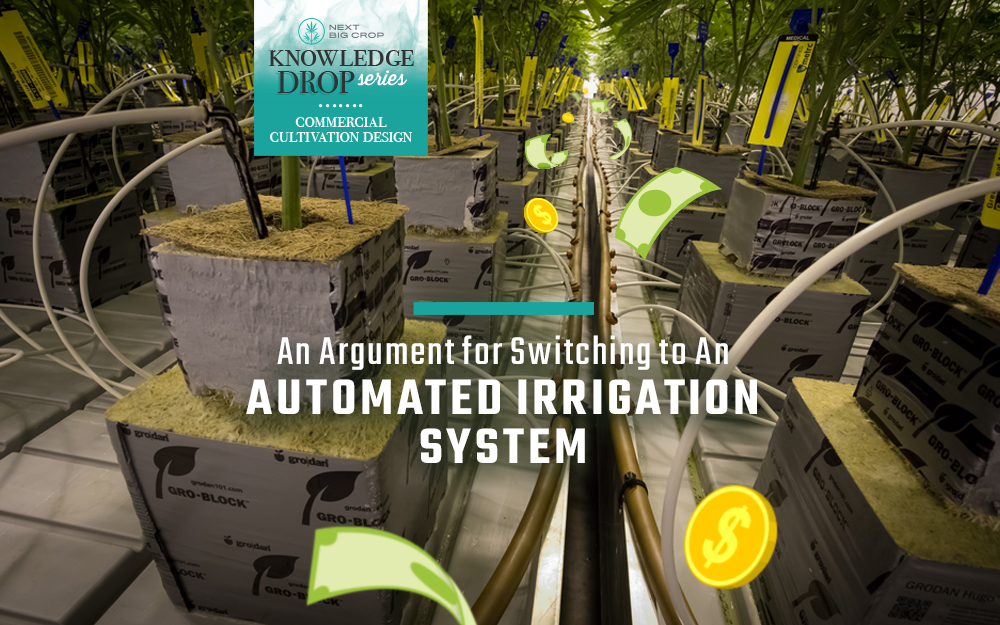By Aaron Mullins, Systems Coordinator at Next Big Crop
A cultivation-facility manager has a lot of balls to juggle: maintaining the production schedule, ensuring compliance, troubleshooting—not to mention making sure that potentially tens of thousands of plants in all stages of growth are thriving. And that manager’s job has gotten a lot tougher in the midst of the coronavirus pandemic in which businesses are forced to alter staff hours in the face of rapidly changing government orders. For a facility to maintain its output and proper plant care whether fully staffed or on a skeleton crew, there are ways to ease the burden.
“Automated irrigation is invaluable for any commercial cultivator, especially in times like this,” Alex Fermon, marketing coordinator at Argus Controls, explains.”If you can’t be on site or you run into staffing shortages, it’s critical to have the capability to manage your grow remotely, with only a few people on site. Systems like ours equip cultivation managers with automated monitoring and control applications, which provides real-time data and remote decision making capabilities. It’s the best way to ensure your irrigation systems are running properly when you’re not there.”
An automated irrigation system for cannabis cultivation can be a facility manager’s best friend and trusted partner, serving as an invaluable tool that saves countless hours in labor-intensive, daily watering and feeding. Added benefits include freeing up staff to focus on necessary operations and establishing more-consistent, better-quality harvest batches.
There are several very good reasons why an automated irrigation system for cannabis cultivation is an excellent investment—and one that quickly pays for itself—for mid- to large-scale operations.
Regularity, Automatically
Do your plants get fed on schedule every time? And is that true for every plant throughout the facility? Or only the ones the staff starts with? Are the plants getting a consistently measured and mixed blend of nutrients? And does the staff always test the blends to make sure?
If you answered yes to all of the above, you either spend every waking hour obsessing over plant-care scheduling or you use an automated irrigation system.
Of course, most growers would like to be so obsessed, but this is just one of a never-ending laundry list of things to keep track of—and cutting corners is almost inevitable. The good news is that you don’t have to worry about your staff taking shortcuts.
An automated irrigation system for cannabis cultivation will be more consistent and more on schedule than your most fastidious employee. Even better, automation lets you use your staff’s abilities where they make the biggest difference: ensuring that daily operations go smoothly.
Managers can also monitor the irrigation system remotely, which is of critical importance as state and municipal work-from-home mandates for COVID-19 take hold in an increasing number of business sectors as officials scramble to contain the spread of localized outbreaks.
Great Growers Use Great Tools
People tend to be willing to accept that an automated irrigation system for cannabis cultivation will help with consistency, but what about quality? Isn’t that best left for master growers with dirt under their nails? Yes, but any master grower knows that you use the best tools available, and a good automated system is a fantastic tool.
Instead of the painstaking measurements and testing that come with blending and testing your nutrients, the human labor is reduced to a brief, online setup—which can be a game-changer when facility staffing is in flux.
The system tests the nutrient levels before and after the mixing process to confirm that you are getting what you asked for. That abundance of information also extends to things such as soil moisture, allowing you to keep a close eye on all your plants, even when they number in the tens of thousands.
Automation also makes for efficient troubleshooting and integrated pest management, or IPM. The consistency discussed above takes much of the guesswork out of spotting the sources of problems, and automated feeding and mixing allow for the efficient delivery of treatment solutions and other beneficials to control bugs, mold and mildew.
There’s another huge perk: You don’t have to scrub out the tanks since automated systems make it easier to run cleaning solutions through the system. That is a huge pain and expense that you can avoid every week.
Impressive ROI
In our experience installing these systems, Next Big Crop has found that an automated system for a typical 20,000-square-foot facility will pay for itself in six months to a year.
For a larger facility, the payback time can be three months or less.
So, what is the cost? While these systems can run between $20,000 and $50,000 and it’s tempting to say, “I can do that myself and save a bunch of cash,” by the end of the year, it’s the person next to you who ponied up at the beginning who is saving money.
There are more than enough areas where there is no substitute for human eyes, hands and brains, but keeping an exact schedule of watering and nutrient mixing, testing and feeding your plants is best left to consistent automation.
Freeing up staff to focus on other aspects of the facility’s operations matters now more than ever to ensure that your business can continue to function and plants receive the human care they require with fewer team members working in the facility at any given time.
Learn more about Next Big Crop’s systems integration services.
